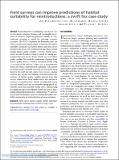Files in this item
Field surveys can improve predictions of habitat suitability for reintroductions : a swift fox case study
Item metadata
| dc.contributor.author | Paraskevopoulou, Zoe | |
| dc.contributor.author | Shamon, Hila | |
| dc.contributor.author | Songer, Melissa | |
| dc.contributor.author | Ruxton, Graeme | |
| dc.contributor.author | McShea, William J. | |
| dc.date.accessioned | 2021-11-08T15:30:17Z | |
| dc.date.available | 2021-11-08T15:30:17Z | |
| dc.date.issued | 2021-10-07 | |
| dc.identifier | 276578960 | |
| dc.identifier | 450a532e-76a7-43eb-b0cf-6cc272316da4 | |
| dc.identifier | 85117096651 | |
| dc.identifier | 000779741400001 | |
| dc.identifier.citation | Paraskevopoulou , Z , Shamon , H , Songer , M , Ruxton , G & McShea , W J 2021 , ' Field surveys can improve predictions of habitat suitability for reintroductions : a swift fox case study ' , Oryx , vol. FirstView . https://doi.org/10.1017/S0030605320000964 | en |
| dc.identifier.issn | 0030-6053 | |
| dc.identifier.other | RIS: urn:6E643D6C029E9D50CA0A099D3627E2F0 | |
| dc.identifier.other | ORCID: /0000-0001-8943-6609/work/102725589 | |
| dc.identifier.uri | https://hdl.handle.net/10023/24285 | |
| dc.description.abstract | Reintroductions are challenging, and success rates are low despite extensive planning and considerable investment of resources. Improving predictive models for reintroduction planning is critical for achieving successful outcomes. The IUCN Guidelines for Reintroductions and Other Conservation Translocations recommend that habitat suitability assessments account for abiotic and biotic factors specific to the species to be reintroduced and, where needed, include habitat quality variables. However, habitat assessments are often based on remotely-sensed or existing geographical data that do not always reliably represent habitat quality variables. We tested the contribution of ground-based habitat quality metrics to habitat suitability models using a case study of the swift fox Vulpes velox, a mesocarnivore species for which a reintroduction is planned. Field surveys for habitat quality included collection of data on the main threat to the swift fox (the coyote Canis latrans), and for swift fox prey species. Our findings demonstrated that the inclusion of habitat quality variables derived from field surveys yielded better fitted models and a 16% increase in estimates of suitable habitat. Models including field survey data and models based only on interpolated geographical and remotely-sensed data had little overlap (38%), demonstrating the significant impact that different models can have in determining appropriate locations for a reintroduction. We advocate that ground-based habitat metrics be included in habitat suitability assessments for reintroductions of mesocarnivores. | |
| dc.format.extent | 10 | |
| dc.format.extent | 932286 | |
| dc.language.iso | eng | |
| dc.relation.ispartof | Oryx | en |
| dc.subject | Field survey | en |
| dc.subject | Habitat quality | en |
| dc.subject | Habitat suitability | en |
| dc.subject | Mesocarnivore | en |
| dc.subject | Reintroduction | en |
| dc.subject | Swift fox | en |
| dc.subject | Vulpes velox | en |
| dc.subject | QL Zoology | en |
| dc.subject | NDAS | en |
| dc.subject.lcc | QL | en |
| dc.title | Field surveys can improve predictions of habitat suitability for reintroductions : a swift fox case study | en |
| dc.type | Journal article | en |
| dc.contributor.institution | University of St Andrews. School of Biology | en |
| dc.contributor.institution | University of St Andrews. Centre for Biological Diversity | en |
| dc.identifier.doi | https://doi.org/10.1017/S0030605320000964 | |
| dc.description.status | Peer reviewed | en |
This item appears in the following Collection(s)
Items in the St Andrews Research Repository are protected by copyright, with all rights reserved, unless otherwise indicated.

